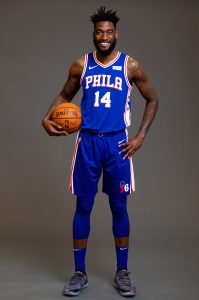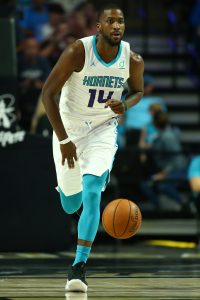Once the NBA trade deadline passes, the league’s buyout season begins. What exactly are buyouts, and how do they work? Today’s Hoops Rumors glossary entry will examine those questions. Let’s dive in…
While the term “buyout” is often applied colloquially when any veteran is released after the trade deadline, it applies specifically to a player who gives up a portion of his salary to accommodate his release. Rather than waiving a player outright, a team will negotiate the terms of the player’s release. Then, once the player clears waivers, his guaranteed salary with his previous team will be reduced or eliminated altogether.
The most common form of buyout involves a veteran player on a non-contending team being granted his release during the final year of his contract to join a playoff club down the stretch. It typically happens after the trade deadline because by that point there’s no other way for a player to change teams.
Kidd-Gilchrist and Williams fit this bill. The 18-36 Hornets aren’t going to make the playoffs and are focused on developing their young players. Buyouts for Kidd-Gilchrist and Williams gave those two players the opportunity to join the Mavericks and Bucks, respectively — now they’re both headed to the postseason.
For the player, the motivating factor is generally the desire to play for a winning team. In their buyouts with Charlotte, Kidd-Gilchrist and Williams gave up roughly the amount of money they’ll make on their new prorated minimum-salary contracts, so they won’t come out ahead financially — they’ll just get a chance to play in the postseason before returning to free agency in the summer.
As for the team, there’s little downside to letting a veteran go, since the player is usually in the final year of his contract and the club completing the buyout is rarely in contention for a playoff spot. Buying out that veteran can save the team some money, earn some goodwill with a player and an agent, and open up minutes for a younger player to take over.
What happens if a team and player reach a buyout agreement, then the player is claimed off waivers?
Waiver claims are rare in the NBA, particularly for players earning more than the minimum salary. If a team doesn’t have the cap room available to fit a waived player’s salary, that team needs a trade exception or disabled player exception big enough to accommodate that player’s salary. Otherwise, it can’t place a claim.
Those rules made it virtually impossible for any NBA team to claim a player like Williams, who had been earning $15MM in Charlotte. No NBA teams currently have that much cap room or that big a disabled player exception. The Warriors’ $17MM+ trade exception is the only tool that could’ve been used to place a claim on Williams, but Golden State’s hard cap made even that scenario an impossibility.
Although Williams agreed to give up about $956K as part of his buyout with the Hornets, that amount isn’t removed from his cap charge until after he clears waivers, so any team wanting to claim him needed to be able to accommodate his original $15MM salary (not that adjusting that number to $14MM would have changed the equation for any teams anyway).
The rarity of NBA waiver claims is the reason why a player who receives a buyout often reaches an agreement with a new team even before he has cleared waivers. The odds of a waiver claim are so low that it usually doesn’t make sense for a player to wait until he’s officially a free agent to start negotiating. The team completing the buyout almost always gives the player’s agent the go-ahead to open those talks with potential suitors. It’s a win-win, since a player who knows he has a landing spot lined up is more likely to give back a little extra money to his old team.
In the unlikely event that a bought-out player is claimed on waivers, the buyout agreement between him and his previous team is no longer necessary — since his new team is taking on his original contract, his old team will no longer owe him a single cent or carry his old cap hit. That’s essentially the most efficient possible form of buyout for that team.
How do the cap hits work when a team and player agree to a buyout?
The equation for a player in the final year of his contract is pretty simple — the amount he agrees to give up in the buyout is simply subtracted from his overall cap hit. Kidd-Gilchrist, for instance, agreed to surrender $810,763 from his $13MM salary, reduced his cap charge for the Hornets from $13,000,000 to $12,189,237.
For a player who isn’t in the final year of his contract, the calculations are a little more complicated, and depend on when exactly the buyout is completed.
For instance, Jamal Crawford agreed to a buyout with the Hawks during the summer of 2017. At the time, he had $17,246,988 in guaranteed money left on his contract – $14,246,988 for 2017/18 and a partial guarantee of $3MM for 2018/19.
Crawford agreed to give up $4MM, which worked out to about 23.2% of his overall guarantee. That meant reducing each season’s cap hit by 23.2%, which left Atlanta with charges of $10,942,762 for the first season and $2,304,226 for the next year.
That 23.2% reduction was applied evenly across two seasons in Crawford’s case because he hadn’t been paid any of his salary for the coming season. In cases where a player is bought out later in the league year, the formula is weighted less heavily toward the current league year.
During the 2015/16 season, for example, Andrea Bargnani agreed to a buyout with the Nets after the trade deadline. At the time, he had a cap hit of $1,362,897 for ’15/16, with a $1,551,659 player option for 2016/17. Bargnani gave up his full ’16/17 option salary as part of his buyout, resulting in respective cap charges of $1,039,298 and $323,599.
Is there a deadline for buyouts to get done?
There’s technically no deadline, but March 1 is the date to watch. Players bought out and/or waived after that date aren’t eligible to play in the postseason for a new team.
That March 1 cut-off can cause some confusion — a player doesn’t necessarily have to be signed to his new team by then in order to be playoff-eligible. For instance, a player who is waived by one team on February 25 and then signs with a different team on April 10 would be postseason-eligible for his new club. A player who has been out of the NBA all season (Joakim Noah, for example) would also retain his postseason eligibility if he were to sign with a team in March or April.
Are there restrictions for where a player who receives a buyout can sign?
If a player agrees to reduce his guaranteed salary as part of his buyout, he can’t re-sign with the team that waived him for a full year, or until his contract would have ended, whichever is later. So if the Grizzlies had bought out Dion Waiters this season, they wouldn’t have been eligible to re-add him to their roster until the 2021/22 league year, after his contract would have ended. Because Waiters didn’t give up any money as part of his release, that restriction doesn’t apply to him.
A player who is bought out or waived after being traded can’t re-sign with the team that traded him away until the one-year anniversary of the deal, or until the July 1 after his contract ends, whichever comes first. For example, since Waiters was traded from Miami to Memphis before being waived, the Heat would be ineligible to re-sign him this season.
There’s one exception to this rule — if a player is traded twice during the same league year and then is bought out or waived, he can return to the first team that traded him. For example, in July, the Hawks traded Solomon Hill to the Grizzlies, who flipped him to the Heat at the deadline. If Miami were to waive Hill, he’d be ineligible to return to New Orleans this season, but he could sign with Atlanta.
Who are some of the remaining buyout candidates for 2020?
We’re keeping tabs on the buyout market right here, with a list of potential candidates that we’ll continue to update through March 1.
Note: This is a Hoops Rumors Glossary entry. Our glossary posts will explain specific rules relating to trades, free agency, or other aspects of the NBA’s Collective Bargaining Agreement. Information from Larry Coon’s Salary Cap FAQ and ESPN’s Bobby Marks was used in the creation of this post.
An earlier version of this post was published in 2018. Photo courtesy of USA Today Sports Images.

 So far this season, we’ve seen Hornets forwards
So far this season, we’ve seen Hornets forwards